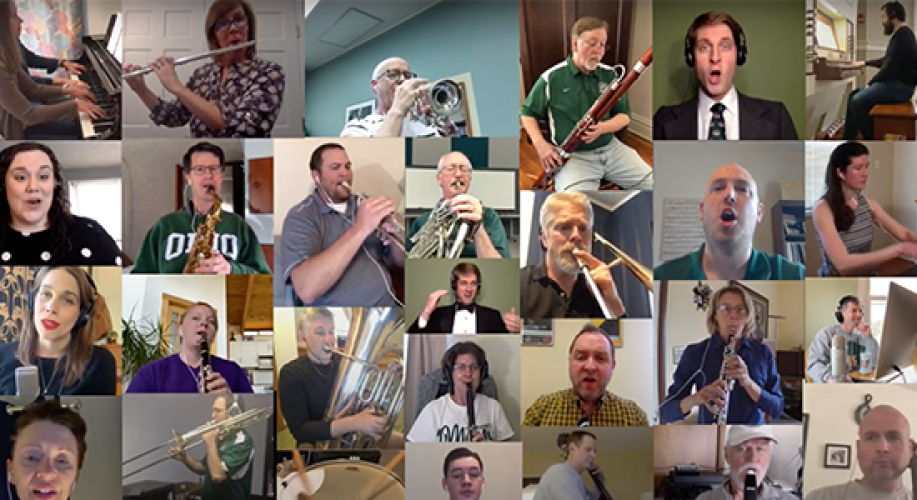
OHIO School of Music faculty embrace technology to help performing arts students

For performing art students, the current orders for physical distancing in response to COVID-19 is making it even harder to work as an ensemble and perform. Although this challenge is present for numerous students and faculty in several other departments, faculty in OHIO’s School of Music are finding new, innovative ways to teach performing as an ensemble through various technology.
As many people saw during Ohio Gov. DeWine’s press conference, the Marching 110 used several different technologies to create a performance of OHIO’s fight song, “Stand Up and Cheer,” while physical distancing. The video combines several members of the 110’s individual, remote recordings into one performance, proving that even while apart there are ways ensembles can come together virtually.
According to Assistant Professor and Director of Choral Activities Bradley Naylor the last time the Singing Men of OHIO (SMO) performed as an ensemble was at the end of their spring break tour which was cut short due to COVID-19. For SMO, as well as several other classes Naylor teaches, coming together and learning how to perform as an ensemble is the basis of their class and not easily doable when physical distancing.
“There is no way for musicians to perform together, distantly, in real-time; the laws of physics just don’t allow it,” Naylor said. “What ensemble directors are doing now, using technology, is keeping students connected to and invested in each other and the repertory until we can join together again in song.”
Between researching on several online forums and collaborating with other faculty members to figure out what works in teaching to an ensemble online, Naylor came across an app that would allow for musicians to record multiple video tracks and stack them on top of the other. He experimented with the app, recording himself singing each harmony of SMO’s version of Alma Mater OHIO and put the tracks on top of each other to create the sound of one ensemble.
“Having the ability to do something with others that you can’t do by yourself is one of the main reasons of being part of an ensemble,” Naylor added. “And finding ways, such as apps to do that, still allows us to accomplish this collaborative aspect.”
Alison Brown Sincoff, professor of flute and chair of performance studies, has also been working on ways students can create the best quality performances from the comfort of their homes when professional instruments and accompaniment aren’t accessible.
“There are several free and more accessible ways students can use certain technologies to continue to study their instrument,” Sincoff said. “For instance, there are many free YouTube backing tracks to accompany them, as well as an option on several video chat platforms that allow the audio settings to be adjusted to better pick up the instrument’s pitches.”
Another way performing arts students in the School of Music are able to perform is with help from the school’s staff pianists, Dr. Florence Mak and Jeremy Vigil, along with some graduate pianists who are currently working to provide quality playback tracks to send to many of the students needing to move forward with various performance requirements.
“Without the services of these fine pianists, many of our students would lose out on creating the best quality performance under the current circumstances,” Sincoff explained. “We are so fortunate to have in particular, Florence and Jeremy to lead this essential collaboration, both in live and recorded instruction.”
For Christopher Fisher, professor of piano, assistant director of the School of Music, and recently named Yamaha Artist, he’s had the opportunity to test out pianos with innovative technology that can interface with his students’ instruments.
Part of the honor of being named a Yamaha artist is access to a variety of technology like the brand-new Yamaha Disklavier Enspire, which is a hybrid instrument that is both an acoustic and digital instrument.
With this new technology, Fisher can connect with other instruments that also support the same software and can interface the Disklavier piano over any broadband internet connection. This allows for students to play their digital piano at home and then connect to the Yamaha piano where the keys and pedals will actually move to show Fisher the student’s physical use of the piano. The sound is also exactly replicated on the Disklavier.
“The pandemic has created quite a sizeable learning curve in which teachers are challenged to identify new strategies for best reaching their students while learning and adapting to new technologies,” Fisher said. “For me and my students, having access to the new Disklavier technology has been truly an extraordinary opportunity. I wish to thank Yamaha and Solich Pianos for making this possible.”
Naylor also included that for musicians, not all jobs may be performing live.
“I do professional choral singing in New Mexico with 24 other singers who come from all over the country and who have significant performing careers just through traveling and performing different repertoire,” he said. “By having to learn how to perform virtually, our students are only growing their performing skills and seeing the various ways they can produce music outside of the classroom. It is amazing to see all the virtual concerts and ways social media is being used to keep the artistic community knitted together.”
